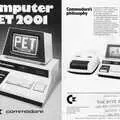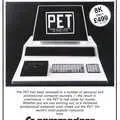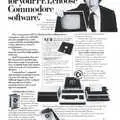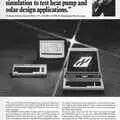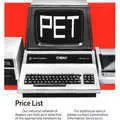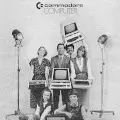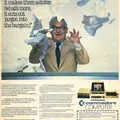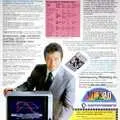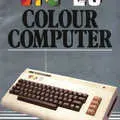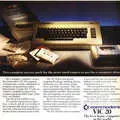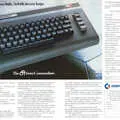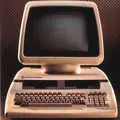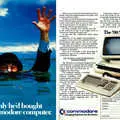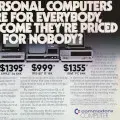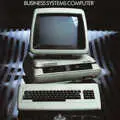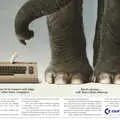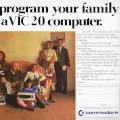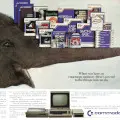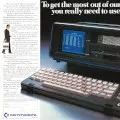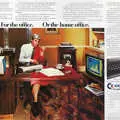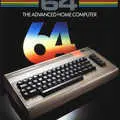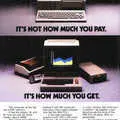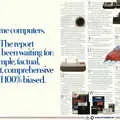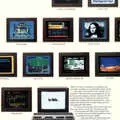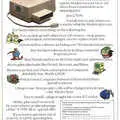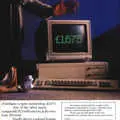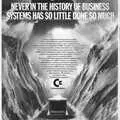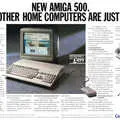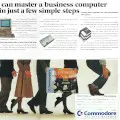
Commodore Advert - 25th August 1984
From Personal Computer News
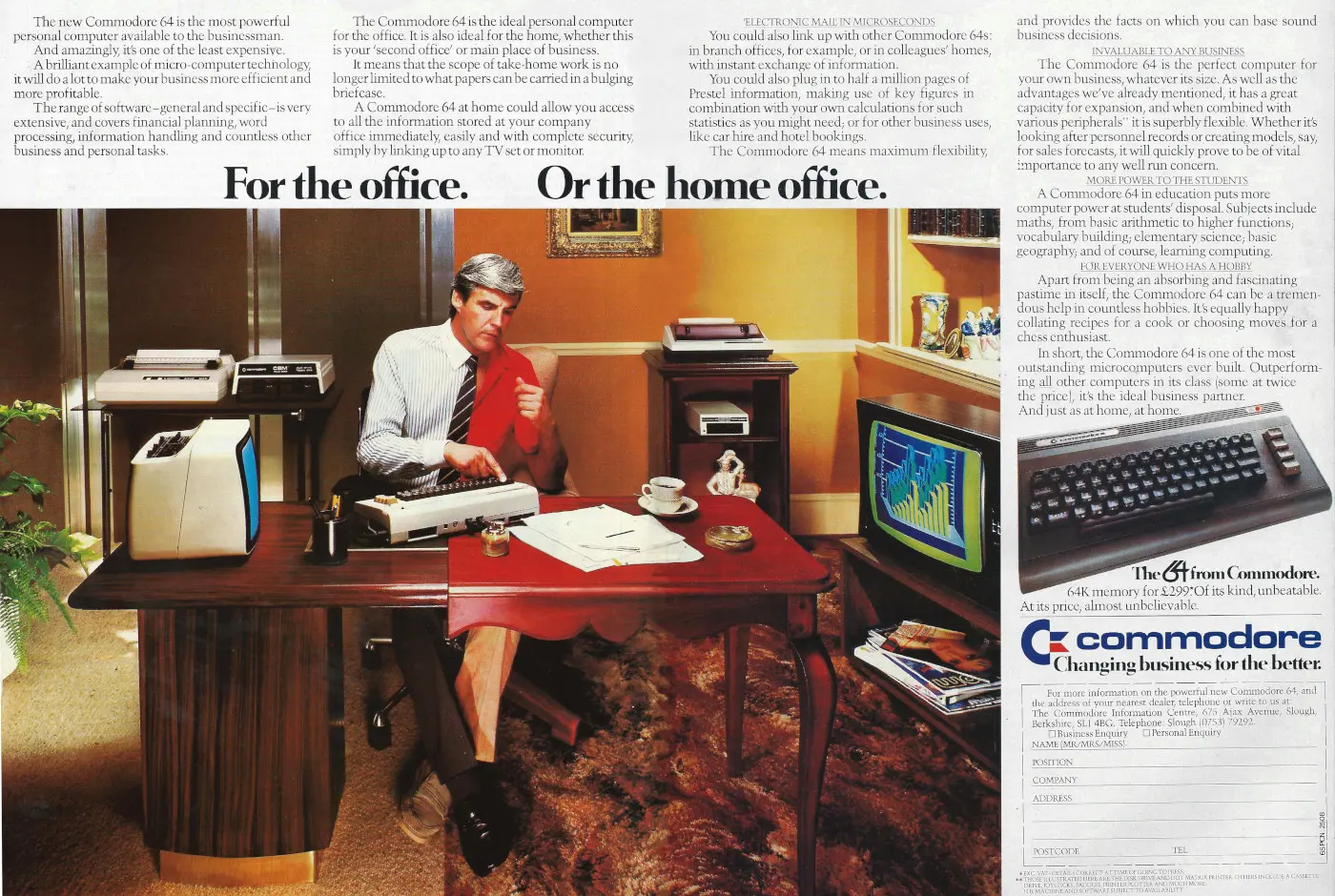
For the office. Or the home office.
It's a nicely-illustrated advert showing some dude as half in an office and half working at home - split down the middle whilst one-finger-typing on a Commodore 64.
Commodore is clearly trying to position the 64 as a business machine, and with a range of printers and floppy disk drives available it's not entirely implausible.
However it's three years into the reign of the IBM PC, which was in the process of sidelining pretty much everything else in its wake.
The Commodore 64 - launched in January 1982 but not really available until August of that year, and not available in the UK until early 1983 - was retailing at £299 - about £1,260 in 2025 terms and still the same as its launch price.
The idea of working from home, the home office and telecomuting might seem to be something that took off only after the enforced confinement of Covid lockdowns in 2020 and 2021.
However it's been around ever since the first acoustic-coupler modems allowed the few users with a computer at home to dial up the office mainframe in the 1970s.
The word telecommuting was itself coined by NASA engineer Jack Nilles in 1972[1]. By 1982, Nilles, now a director of interdisciplinary programs at the University of Southern California and author of a book on telecommuting, had become known as a "trend watcher" and was suggesting that widespread telecommuting would occur within the next ten years and that 15 to 20% of Americans would be working from home by that time.
By the end of the 1970s, the explosion in affordable home computing had started to make widespread telecommuting more of a reality, with a prediction about working from home "electronically" cropping up in Alvin Toffler's book "The Third Wave", published in 1980. US computer magazine Personal Computing picked up the subject in a pair of essays in its May 1982 edition, where author of "How to make telecommuting work[2]", Dr. Evan Peelle, opened with the statement:
"What was once a figment of science fiction imagination has become a reality. From the Industrial Revolution we have been propelled into the Technological Revolution so rapidly that the distance between future and present has blurred. Major social and organizational change is occuring almost without us even knowing it. Technology is indeed revolutionising the way we perform our jobs, relate to each other, and manage our businesses".
The rise of the Personal Computer - not particularly in the sense of the IBM 5150, but any computer that suited an individual and which could sit on their desk in a bedroom or on the kitchen table - was the key to remote working, as computers offer access to information, and information in the modern world was an emerging form of power. That sort of power, which once only belonged to large institutions, could now belong to the individual.
Dr. Peelle continued:
"There is increased feedom and control - in this case over time and space. You can now work at your own pace in the environment of your choice - not only in your home, but on the ranch or from a mountain hideaway. The hassle, time and expense of commuting can be eliminated. The excitement of living on the leading edge and the challenge of innovating may also be an attraction".
There followed a list of tips as given by a manager "in the personal computer industry" which despite being written in 1982 looks identical to 2025:
- Set objectives and plan, organise and schedule your time. Discipline yourself
- Separate your personal and work lives even though they are taking place in the same environment. Plan time to relax and maintain social or family relationships
- Don't lose sight of the fact that a computer is means to an end, not an end in itself. Focus on results
- Concentrate on effective communication, making the most of your brief contacts. The key is quality, not quantity
- Isolation - learn to appreciate the interactive qualities of your computer
Despite the enthusiasm, it took 40 years and a global pandemic to really make telecommuting commonplace, and the same fears about the potential impact on society if widespread homeworking occured was in place even in 1982.
In something of a counterpoint, Margo Downing-Faircloth, an editor for the Dow Jones News service, wrote in the same edition of Personal Computing about the question "Would Working At Home Be Wise?[3]". She started with a fictional prediction:
"Just eight years ago Stephen was a highly visible professional on the move. He never planned to retire to his plush suburban condominium, where his three-piece suits are beyond irrelevance. But with soaring energy and utility costs and a failing system of public transportation, his company chose to reduce its overhead and operating costs by closing down its inner-city office and installing personal computers in the homes of its employees. Outside, in the modern metropolis, the once bustling streets are quiet. The half-empty downtown office buildings are an embarassment and a sad reminder of the days when they were busy focal points of corporate activity".
Once again, themes that seem very familiar were suggested to explain the resistance to adapting telecommuting, with Cornell University psychologist Charles McCLintock suggesting that working from home "violates a lot of the traditional norms" and that:
"Many people who supervise others often base the quality of their employees' work on how they show up at the office - on time, dressed properly - and on how they deal with others. So how do you supervise people and manage an organisation if nobody's there?".
There were a few forward-looking organisations dabbling with homeworking at the time, such as Blue Shield Medical Insurance in Columbia, South Carolina, which farmed out claims processing to a team of remote workers known as the "cottage keyers".
Each of the small group of employees worked on a piecemeal basis using Texas Instruments' Silent 700 series computers. They were contracted to produce 1,200 claims a week, which were then saved to cassette tape and sent to the company's central IBM 3033 computer.
Also trialling a work-from-home scheme was Control Data Corporation of Mineapolis, which had around 80 of its 48,000 employees involved. Interestingly Control Data's interest was one of environmental awareness. Pat McKennie, administrator of the programme, said
"For the past few years we've been energy conscious. We looked at all the alternative work programs and decided [remote working] might be an excellent way to do it. Many of our employees were travelling or working at customer sites, so they don't really need to go into the office anyway, except for meetings. Telecommuting is beneficial to us because it means that we can offer a range of environmental alternatives".
Perhaps it wasn't really manager resistance that held back telecommuting, as the example of Blue Sheild's remote workers having to submit their processed claims via cassette tape reveals. Maybe it just took a while before network technology got to the point where it was no longer in the way.
In the early 1980s, dial-up lines operated at 300 baud, or 300 bits per second. At that speed it would take about 17 seconds to transmit the equivalent of a single page of characters.
By the mid 90s these were up to nearly 3,500 baud/33.6kpbs, whilst in 1995 ESPN broadcast the audio of a live baseball game over the internet, demonstrating practical streaming for the first time.
By the late 90s digital phone networks were enabling 56 kilobits per second. That sheeet of paper would now take one tenth of a second to transmit.
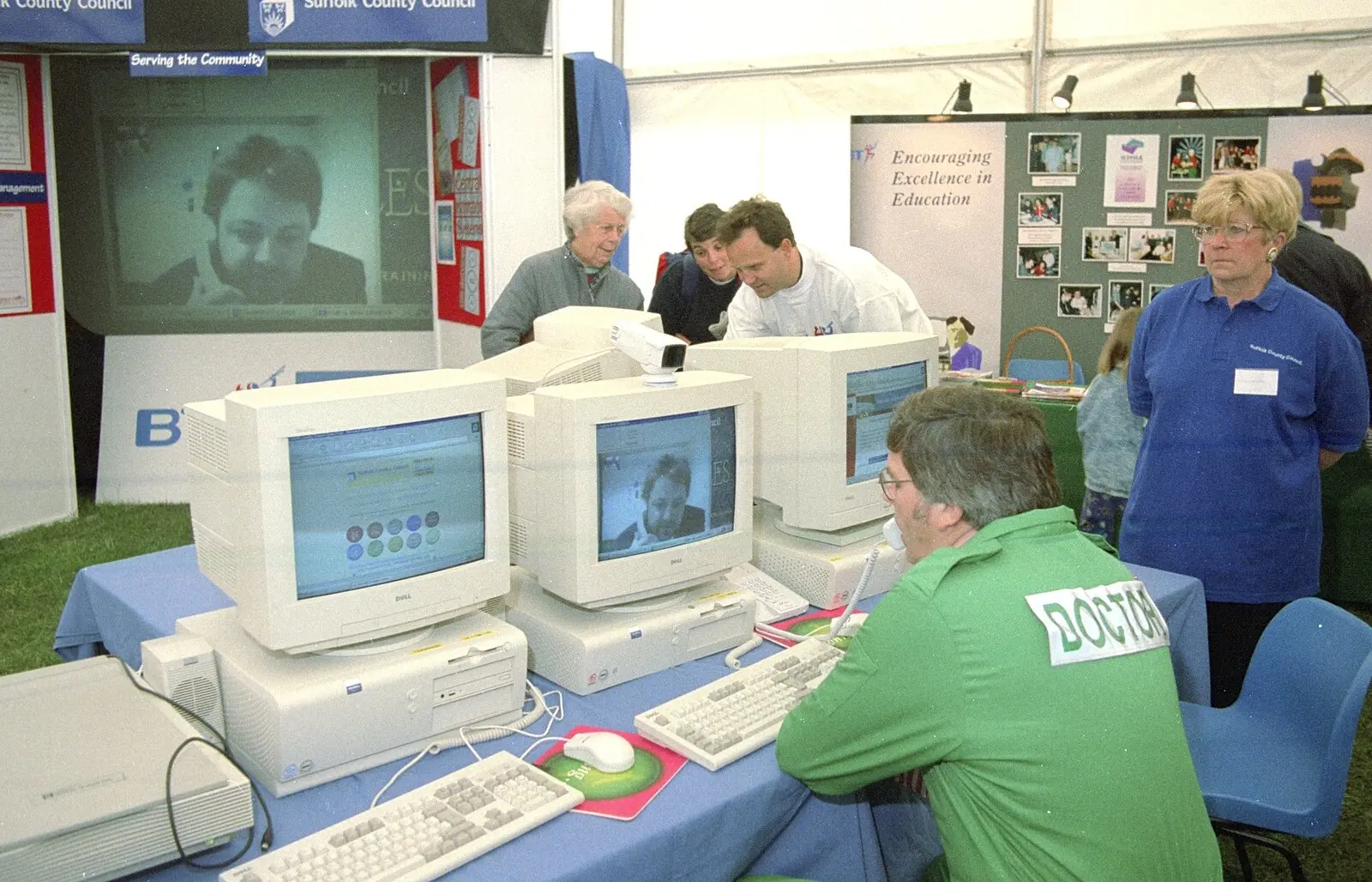
Suffolk County Concillor Chris Mole video-conferences with a Doctor in a tent in a field at the Suffolk Show in 1997. The video is running over a temporary ISDN line installed by BT for the occasion. The system was also used by a deaf group and it enabled them to use sign language with people not in line of sight for the first time ever.
Early video conferencing was also available, although this often required dedicated leased lines or expensive ISDN, however by the latter half of the 90s internet video was becoming a reality, with internet-video-confercing applications like CU-SeeMe, released in 1995, becoming avalailable - although it was still more of a proof-of-concept than the smooth video people really wanted to see.
By the 2010s, broadband internet was widely available and it was said that 100,000 federal employees in the US were working remotely[4]. By 2020 of course, broadband was fairly ubiquitous and applications like Zoom - and somewhat later Microsoft's Teams - were there for when millions of people suddenly found themselves working from home, whether they wanted to or not.
Telecommuting had finally made it - just 40 years later than planned.
Date created: 19 January 2024
Last updated: 11 December 2024
Hint: use left and right cursor keys to navigate between adverts.
Sources
Text and otherwise-uncredited photos © nosher.net 2025. Dollar/GBP conversions, where used, assume $1.50 to £1. "Now" prices are calculated dynamically using average RPI per year.

